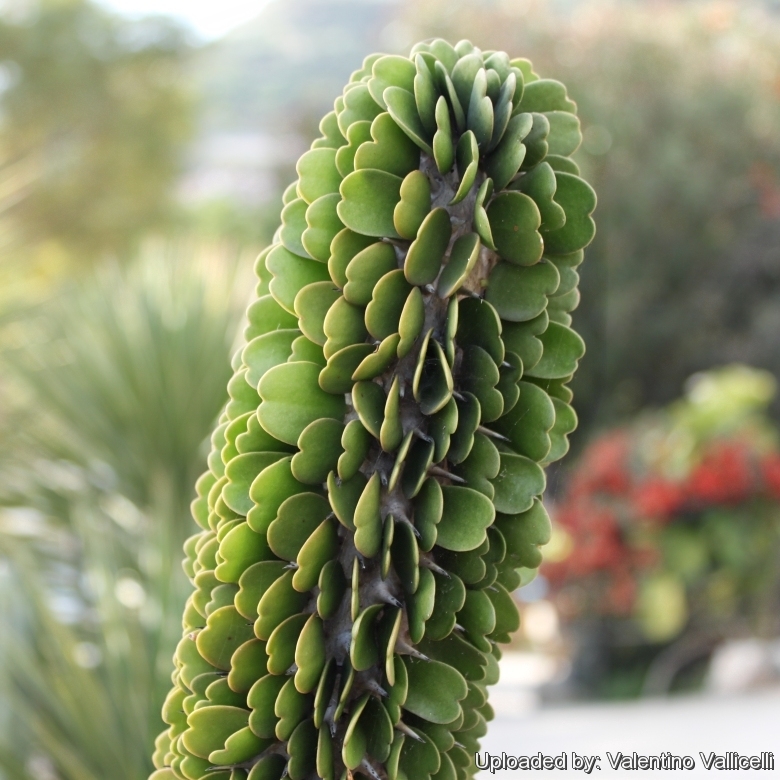




Your support is critical to our success.

Origin and Habitat: Southern Madagascar in the area between Tsiombe and Taolanaro (Basin of the Mandrare River.).
Habitat: It grows in dry spiny shrub forest or dry deciduous thicket. These forests are stratified and Alluaudia ascendens occur in the upper canopy mixed with other species like: Adansonia za (Baobab tree), Operculicarya decaryiSN|29905]]SN|29905]], Alluaudia procera, Commiphora aprevalii, and Tetrapterocarpon geayi.
Synonyms:
- Alluaudia ascendens (Drake) Drake
- Didierea ascendens Drake
Alluaudia ascendens (Drake) Drake
Bull. Mus. Hist. Nat. (Paris) 9: 37 1903
Synonymy: 2
- Alluaudia ascendens (Drake) Drake
- Didierea ascendens Drake
Alluaudia ascendens f. variegata hort.
MALAGASY: Fantsiolotse, songo be
Description: Alluaudia ascendensSN|25189]]SN|25189]] is the tallest species, reaching a maximum height of 15 metres, but it is usually far smaller. It grows initially as a single stem, but then branches forming massive ascending V-shaped crowns. This is the largest of all the Didiereacea. One can recognize this species at a distance by the inflorescences like muffs along the upper portion of the branches.
Trunk: Columnar thick but short, up to 30 cm across, sparsely branched (beginning at 2-4 m), pith lamellar. Branches few nearly vertical. The bark is dull greenish brown, reddish or greyish and resembles unwrinkled elephant skin. The stems carries blunt spines like the knobs on a mace, which circle the trunk along with the leaves, in very vertical helices.
Spines: Persistent, single, 1,5-2 cm long, conical, arranged irregularly along the stems, greyish-white.
Leaves: Short-stalked in spiralling lines, 1,3-2,5 cm long and 10 to 20 mm wide, fleshy, circular or reverse heart-shaped, notched at the apex, dark green, often tinged with purple in full sun.
Flowers: Inconspicuous (rarely seen in cultivation) dull white to reddish in cymose inflorescences up to 12 cm long. Sepals keeled.
Chromosome number: 2n = 240
Subspecies, varieties, forms and cultivars of plants belonging to the Alluaudia ascendens group
 Alluaudia ascendens (Drake) Drake: forms a massive ascending V-shaped crowns up to 15 m tall. Spines single, 1,5-2 cm long. Leaves in spiralling lines circular or reverse heart-shaped. Distribution: S. Madagascar between Tsiombe and Taolanaro.
Alluaudia ascendens (Drake) Drake: forms a massive ascending V-shaped crowns up to 15 m tall. Spines single, 1,5-2 cm long. Leaves in spiralling lines circular or reverse heart-shaped. Distribution: S. Madagascar between Tsiombe and Taolanaro. Alluaudia ascendens f. variegata hort.: Variegated form. Cultivated.
Alluaudia ascendens f. variegata hort.: Variegated form. Cultivated.
Bibliography: Major references and further lectures
1) Urs Eggli “Illustrated Handbook of Succulent Plants: Dicotyledons” Springer, 2002
2) Hilary Bradt “Madagascar” Bradt Travel Guides, 2011
3) William F. Laurance, Richard O. Bierregaard “Tropical Forest Remnants: Ecology, Management, and Conservation of Fragmented Communities” University of Chicago Press, 21/giu/1997
4) Werner Rauh, Herman Schwartz “Succulent and xerophytic plants of Madagascar” Vol. 2 Strawberry Press, 1998
5) Alfred Byrd Graf “Exotica International Series 4: Pictoral Cyclopedia of Exotic Plants from Tropical and Near-tropic Regions : a Treasury of Indoor Ornamentals for Home, the Office, Or Greenhouse : in Warm Climates the Patio and the Garden Outdoors” Roehrs, 1985
6) Alfred Byrd Graf “Tropica: Color Encyclopedia of Exotic Plants and Trees” Roehrs Company, 1986
7) Urs Eggli “Illustrated Handbook of Succulent Plants: Dicotyledons” Springer, 2002
8) A. Jolly, P. Oberle, R. Albignac, “Key Environments: Madagascar” Elsevier, 22 gen 2016
8) Comptes Rendus hebdomadaires des Séances de l’Academie des Sciences. Band 133, Paris 1901, S. 241
9) Bulletin du Muséum d’Histoire Naturelle. Band 9, Paris 1903, S. 37
Cultivation and Propagation: Alluaudia ascendensSN|25189]]SN|25189]] is probably one of the most rare species in cultivation.
Exposure: It needs full sun or high interior lighting with a very well drained soil mix and freely circulating air.
Watering: Plants are watered and allowed to dry thoroughly before watering again.
Fertilization: If fertilizer is used, it should be diluted to ¼ (one-quarter) the recommended rate on the label.
Hardiness: It is a frost tender species that must be protected in the greenhouse over the winter but established plants should tolerate temperatures as low as 0° C (Avoid any frost!). If grown in the home environment, the ideal temperatures should run between 20° to 30° C with winter time temperatures around 10°C. During the winter months, the plant will drop all of its leaves and no water should be given during this period.
Maintenance: Not freely branching. Once this plant is established in its new pot, it should be cut back to encourage branching. The cutting removed can be rooted easily, and the process repeated. If pruned and kept somewhat pot bound, they can be maintained at a manageable size, depending on what ''manageable size'' means to you. If planted in the landscape however, It will often drop all its leaves when it decides to take a rest. When this happens, cut down on the watering until the leaves start to appear again.
Garden uses: This is a terrific plant for those in warmer, drier areas who want something 'different' looking- maybe even a bit weird. Nothing is quite like it for adding interest to gardens, especially when plants are grown in multiples and allowed to create a mini-forest. It has some tough, sharp spines, but because of its very upright habit, is rarely a problem walking around. In Madagascar, the wood of the plant is used in building and for charcoal.
Propagation: Alluaudia ascendensSN|25189]]SN|25189]] is propagated from cuttings taken in the spring or from seed when available.
| Your Actions | |
|---|---|
| Back to Alluaudia index | |
| Back to Didiereaceae index | |
 |
Back to Succulents Encyclopedia index |
Privacy stantement - Terms and conditions - How to cite - About us - Feedback - Donate




